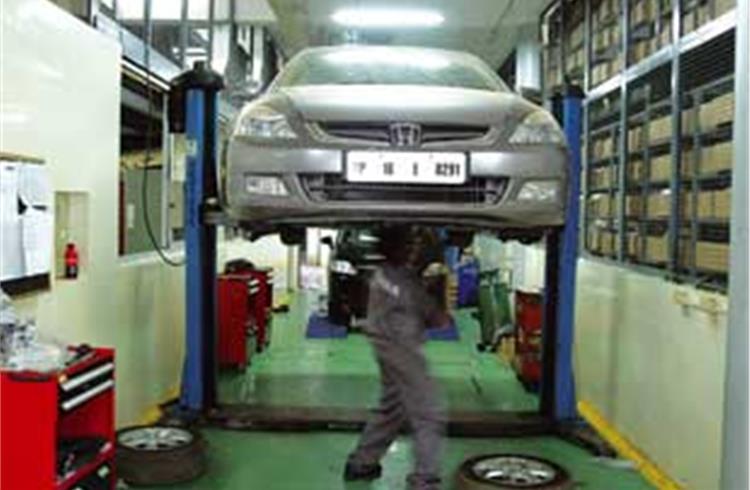The changing face of car service
There has been a remarkable transition over the years and TVS & Sons is ready to meet the challenge, reports T Murrali.
R Srivatchan, president of TVS & Sons (customer centric business), says that in terms of value, authorised service centres support nearly 50 percent of repairs and service. Independent chains take up 30 percent while roadside garages account for the balance.
ROADSIDE HELP
However, when it comes to emergency roadside help, independent chains attract over 50 percent of customers while 30 percent settle for authorised service centres. The unorganised segment does the rest. In the case of accident care, authorised centres take up over 65 percent thanks to their technologically advanced equipment and scientific way of servicing. Branded chains account for 25 percent.
When it comes to buying a car, Srivatchan says, customers travel 20 kilometres on an average and visit five showrooms. However, on the servicing front, they would much rather go in for the personal touch closer to their homes. Customers also get used to a particular service centre based on trust. This could pave the way for multi-brand service centres.
There is enough potential to set up at least one service centre for a 2,000-car community. It is barely one per 9,000 (or even more) now, taking into account 1,500 authorised service centres and 200 independent multi-brand service outlets.
Clearly, as Srivatchan says, it is not possible for a single company to bridge this gap especially in the context of the investments required as well as growing car population. The pragmatic option is to have many participants which, in turn, will lead to healthy competition and better customer satisfaction. Needless to add, better roads will spawn a greater need for roadside help.
With detariffing of motor insurance, Srivatchan sees the emergence of AMCs (annual maintenance contracts) in passenger cars. This will also lead to greater collaborations among insurance/finance companies and independent multi-brand servicing companies. SPURIOUS PARTS
This will restrict the entry of spurious parts into the vehicle and improve quality of service while eliminating disparity in spare parts prices. Insurance and finance companies, he adds, can develop special schemes and leverage AMCs since customers would prefer convenient schemes to service their cars. This will also help the used car market.
In car servicing, customers give top priority to availability, proximity and trust. This calls for rigorous training. Attrition is also on the higher side in this industry because employees build skills and turn entrepreneurs.
With better components, there is little need for replacement of spares and car servicing centres must focus on aesthetics while improving productivity and performance. About a decade ago, the cost of spare parts to labour ratio was 80:20 and it is now 60:40. This will further fall to 40:60 with better vehicles and parts, which Srivatchan reiterates is good for the garage industry.
The challenge is to give the customer a feeling of good service. In his view, providing roadside emergency help is a specialised function for which customers must pay. MyTVS has been providing aggressive on this aspect in Tamil Nadu and people are willing to pay for quality service.
According to Srivatchan, authorised workshops are costlier than independent ones which focus on repairs (rather than replacements), personalised service and go in for lower labour rates per hour. The challenge is to manage cost of accidents by adopting repairs (instead of mindless replacements), standardised estimation methods and enhancing productivity. Insurance companies concentrate more on managing cost of claims but the idea is to do this without hurting the long-term viability of repair shops, he adds
RELATED ARTICLES
Branded content: HL Klemove inaugurates first Local ADAS Radar Manufacturing Unit in India, marks a significant achievement in “Make in India” initiative
The inauguration ceremony was held in the presence of Vinod Sahay, President and CPO of Mahindra & Mahindra Ltd. and Dr....
BluWheelz to 'Green Up' logistics sector
With their EVs-as-a-service solution, the startup is playing it smart with costs and looking to electrify the entire seg...
BRANDED CONTENT: Spearheading the EV revolution in India
Jio-bp is a joint venture between Reliance Industries and BP PLC where both entities have married international expertis...





 By Autocar Pro News Desk
By Autocar Pro News Desk
 27 Feb 2007
27 Feb 2007
 3004 Views
3004 Views









